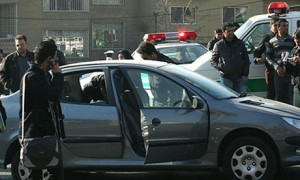The Guardian | December 5, 2010
By Julian Borger and Saeed Kamali Dehghan
Sophisticated cyber-worms, motorcycling assassins: but who is behind the increasingly sinister campaign against the Iranian energy programme?

Iranian police beside the car in which Majid Shahriari was killed in a bomb attack. Photograph: -/AFP/Getty Images
Tehran’s streets at the height of the morning rush hour resemble a vast, sprawling car park. Bumper-to-bumper traffic, much of it stationary, the acrid steam of a thousand exhausts hanging in the cold winter air. If you wanted to kill someone, this would be the moment to do it: when they are stuck in their cars – sitting targets.
At 7.40am last Monday, in north Tehran’s Aghdasieh district, a motorcycle threaded its way through the long lines of cars on Artesh Boulevard. It edged up to a silver Peugeot 405, hesitating alongside for moment, before moving off into the maze of vehicles. A few seconds later there was a bang from the side of the Peugeot, as a small bomb stuck on to the window detonated, killing one of the men inside. The driver and a woman passenger were wounded.
At the same time, a few kilometres to the west, an identical attack was under way. A motorcycle came up beside another Peugeot and then moved on, but this time a man immediately jumped out of the car, ran around to let a woman out on the other side, and both of them managed to scramble a couple of metres from the car before the bomb went off. They were bloodied, but survived.
The dead man was Majid Shahriari, a senior Iranian nuclear scientist. The head of Iran’s nuclear programme, Ali Akbar Salehi, who attended his funeral, said Shahriari had been “in charge of one of the great projects” at Iran’s atomic energy agency – a project he did not describe any further.
The wounded man, Fereydoun Abbasi, was a 52-year-old nuclear scientist working for Iran’s defence ministry, one of “Iran’s few experts on fissile isotopes and the ministry’s laser expert”. He is also named in a UN security council sanctions resolution as working on “banned nuclear activities” with Mohsen Fakhrizadeh, the scientist suspected by inspectors at the International Atomic Energy Agency of running Iran’s secret nuclear weapons programme. The wives of both scientists were wounded in the attacks.
The attacks had clear echoes of the unsolved assassination in January this year of one of their colleagues, particle physicist Masoud Alimohammadi. He was killed in north Tehran on his way to work, at about the same time of the morning, by a bomb strapped to a motorcycle. After his death, to the surprise of many of his students, it was reported that he also had links with Iran’s nuclear programme.
If there were any doubts after Alimohammadi’s killing back in January, there could be none after last week’s double attack. Someone is trying to kill nuclear scientists linked to Iran’s defence establishment – the people most likely to be involved in the covert side of Iran’s nuclear programme, the making of nuclear weapons.
In the febrile atmosphere of Iranian underground politics, speculation quickly spread that the dark forces of the state were at work against would-be dissidents, leakers or defectors, but those rumours quickly evaporated. The Islamic Republic has many other ways of taking people it suspects out of circulation. It has little to gain by sacrificing the nation’s must strategic asset – its nuclear know-how, the teachers of a new generation of atomic scientists. After last week, that new generation must be wondering whether to change career.
The Tehran regime itself had little doubt over who was to blame. President Mahmoud Ahmadinejad quickly pointed the finger at “western governments and the Zionist regime”.
Ahmadinejad blames almost every national setback on the same culprits, but in this case there were no snorts of derision from the security analysts and intelligence experts in the west, but rather murmurs of assent.
There is general agreement that the nature of the simultaneous attacks was too sophisticated to be entirely home-grown – the work of the handful of groups who harry the Islamic Republic around its ethnic edges, like the Sunni Jundullah group, the Kurdish rebels in the north-east, or the People’s Mujahedin (which has vowed to give up violence to win removal from the US state department’s list of terrorist organisations).
The assassination had the hallmark of well-practised professionals. The explosives were shaped to focus the blast and fire a hail of projectiles into the car at an individual target, with minimal “collateral damage”. The targets were obviously carefully chosen and the attack would have required weeks of surveillance. So even if local assassins were involved, the questions of who trained and funded them and assigned the targets would remain.
Time magazine last week claimed to have been given details of the attack from “a western intelligence expert with knowledge of the operation” and asserted that it “carried the signature of Israel’s Mossad”.

